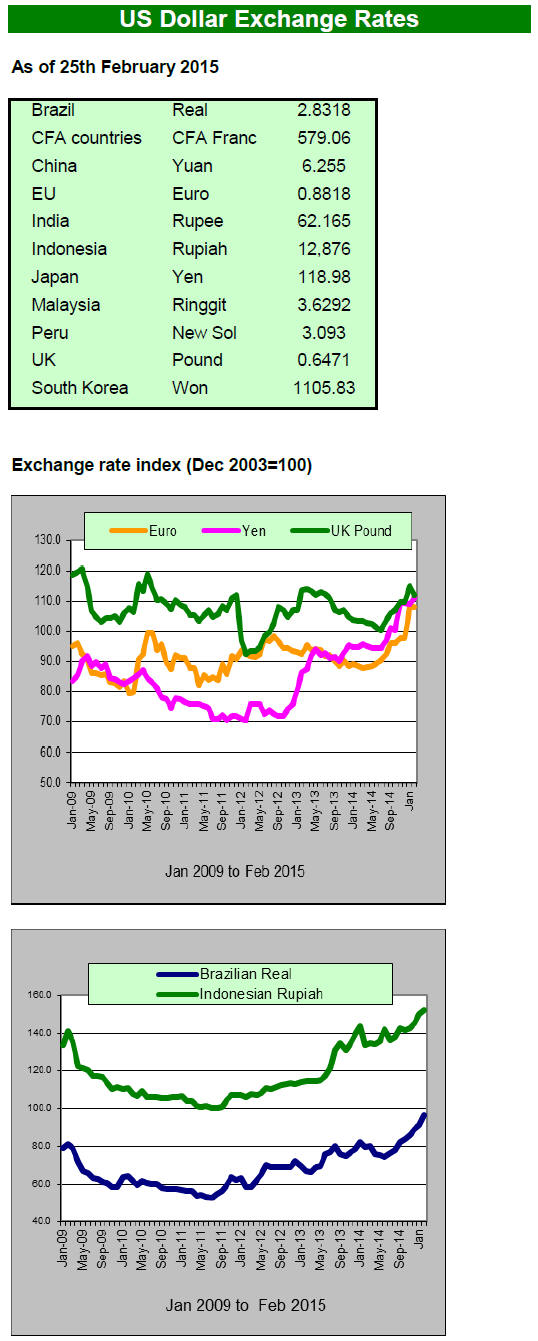2. GHANA
Surge in air dry sawnwood exports as power
outages
limit kilning
Air dried sawnwood exports increased 35% between
January and November 2014 compared to the same period
in 2103. The increase in exports of air dry rather than kiln
dry sawnwood can be attributed to the unavailability of
power for manufacturers to operate kilns.
Ghana is currently experiencing extreme power shortages
and scheduled load-shedding began last year. The ongoing
power crisis is affecting the manufacturing sector
where some companies have lowered production rates and
cut staff numbers.
According to the most recent data from the Timber
Industry Development Division (TIDD) of the Forestry
Commission (FC), Ghana‟s January to November 2014
timber export of 313,799 cubic metres of wood products
earned Euro122.40 million.
Some 21 different products were exported and the
following table illustrates the growth in exports for the
main products.
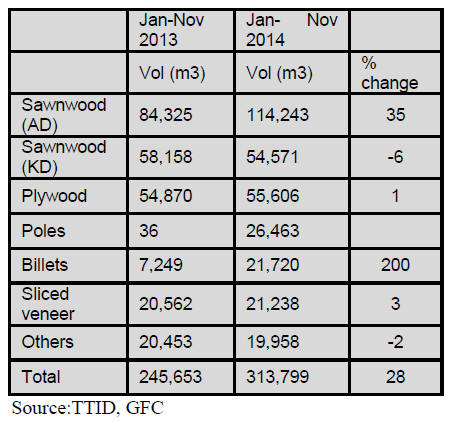
Ghana‟s sliced veneer exports to neighbouring
countries
between January and November 2014 totalled 85 cubic
metres. The main markets were for veneers in Egypt, Italy,
China, Spain and Germany. The major species used for the
production of veneer were asanfina, ceiba and mahogany.
Plywood exports to neighbouring countries continue with
buyers in Nigeria accounting for over 60% of total
regional plywood sales. Nigeria is a major market in the
ECOWAS block and Ghana plans to double exports.
New bamboo craft village
Ghana now has a new centre in the nation‟s capital for
bamboo, cane and rattan artisans known as the Bamboo,
Cane and Rattan Village to serve as a permanent home for
artisans.
The facility was recently handed over by the Millennium
Development Authority (MiDa), to the Ministry of Lands
and Natural Resources.
The Minister for Lands and Natural Resources, Nii Osah
Mills, said the centre opened at an opportune time to
provide a secure work place for artisans. He said the
government was committed to promoting the trade and
development of bamboo and rattan products due to the
enormous economic advantages generated by the sector.
In Ghana, bamboo and rattan resources constitute the two
largest non-timber forest products available.
Trade growth requires upgraded port infrastructure
In a press release the Director-General of the Ghana Ports
and Harbours Authority (GPHA), Mr. Richard Anamoo
has called for a significant investment in infrastructure in
both ports and inland logistics capabilities to meet the
projected demands of some of the world‟s fastest-growing
economies.
The huge growth in trade throughout West Africa and the
projected future growth demanded an upgrade in
infrastructure at various ports in West Africa to handle
greater volumes and larger vessels.
Mr Anamoo, recently attended a three-day West African
Ports and Harbours meeting in Accra which underscored
the need for West African regional ports to collaborate to
boost trade.
The meeting organised by the International Quality and
Productivity Centre, (IQPC), in collaboration with the
Ghana Ports and Harbours Authority and examined
terminal handling efficiencies, how to ease port
congestion, dredging efficiencies, containerisation and
multimodal transport networks.
The meeting focused on operational and construction
challenges affecting port expansion, development and
efficiency for West African ports.
For more see: http://ghanaports.gov.gh/news/1101/IQ-IQPC%2c-
WEST-AFRICAN-PORTS-AND-HARBOURSCONFERENCE-
ENDS-WITH-A-CALL-FOR-PARTNERSHIPTakoradi
Port upgrade
The Port of Takoradi is one of Ghana‟s main commercial
ports handling 65% of the countries commodity exports
such as cocoa, timber, bauxite and manganese. However,
since the port was built in 1928 it had not until recently
benefitted from any major refurbishment.
In 2009 work began to dredge and upgrade Takoradi
harbour. Other work involved extending the breakwater,
the construction of new quays and construction of
additional storage. The Director of the Takoradi Port,
Capt. James Owusu Koranteng, has said work on the
breakwater was 95% complete.
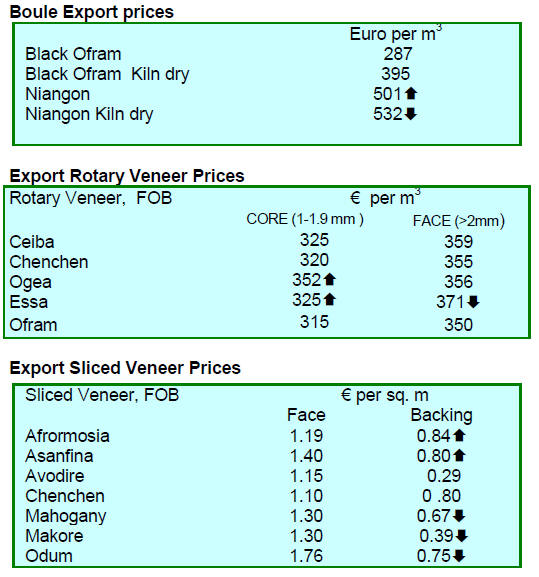
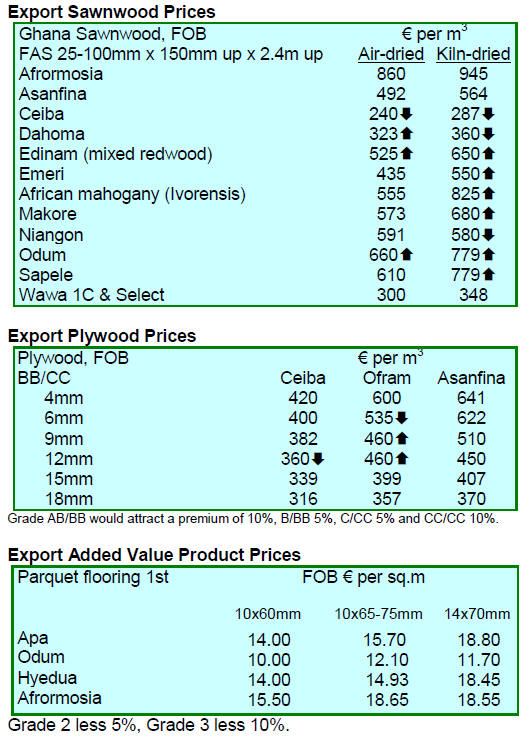
3. MALAYSIA
Quiet trading during Lunar holiday period
Chinese New Year fell on 19 February and that heralded
the start of the Year of the Goat (sheep or ram in some
communities). This is a major festive period for the many
communities in Asia who follow the lunar calendar.
Apart from the official public holidays, the timber industry
in Malaysia usually takes a long break. Some logging
companies break for as long as the traditional 15 days.
However, some processing mills were back at work after
the two day official national holiday.
Both production and trade is very slow over the Chinese
New Year and there have been no market developments of
note.
Strong growth in final Qtr 2014
On the economic front industry watchers were pleasantly
surprised by some good news. Malaysia‟s GDP rose 5.8 %
year on year in the last quarter of 2014 after increasing 5.6
% in the third quarter.
Despite the fall in commodity prices GDP growth was
firm driven by private consumption and investment. The
sharp fall in crude oil prices, a major export from
Malaysia, has forced a revision of the budget and first
quarter 2015 growth may be weaker than initially
estimated. Petroleum income makes up about a third of the
Government‟s annual revenue.
Most economists remain cautious on the outlook for 2015
as they expect the slump in oil prices to have a bigger
impact on exports in the near future.
Bank Negara has said private consumption is likely to
moderate in 2015 especially as consumer sentiment will be
dampened when the new consumption tax rate of 6 % that
is introduced in April.
Exchange rate volatility across the region
All eyes are on the ringgit/US dollar exchange rate. The
Malaysian ringgit is currently at a five year low against the
US dollar but could weaken further. As the strength of the
ringgit is linked to oil prices more exchange rate volatility
can be expected.
Across the region currencies are slipping against the dollar
and many Central banks are cutting interest rates.
Indonesia was the most recent among Asian countries to
lower its domestic interest rate.
In January Singapore loosened its monetary policy to keep
its currency low. China and India have already lowered
their rates. Analysts anticipate Thailand will soon decide
to lower rates.
Healthy export growth in 2014
Malaysia‟s wood product exports grew 9.7% in 2014 year
on year. Wooden furniture and plywood exports accounted
for around 54% of total exports but plywood exports were
down marginally in 2014 compared to 2013 however,
wood furniture exports expanded 10% year on year.
Log exports were a massive 59% higher in 2014 compared
to 2013. The 2014 export statistics from the Malaysian
Timber Industry Board are shown below.

﹛
4. INDONESIA
Ministry of Industry 每 No to log exports
The Minister of Industry, Saleh Husin said the country has
no policy allowing log exports because many wood-based
industries, especially furniture makers, would be adversely
affected.
He said that his ministry fully supported the development
of the national furniture industry, especially the small and
medium-sized enterprises which need help in remaining
competitive in an era of free trade.
There have been suggestions that the Ministry of
Environment and Forestry was considering allowing the
export of specific species as prices for domestic sales by
growers were not competitive with international prices.
Minister Saleh has indicated he will coordinate with the
Minister of Environment and Forestry on this issue.
SMEs benefitting from EU recognition of SVLK
Indonesia‟s wood product exports to the EU are expected
to reach US$1 billion this year according to Indonesia‟s
Ambassador to the EU Arif Havas Oegroseno.
The Ambassador said that recognition of Indonesia‟s
legality verification scheme (SVLK) contributed to a sharp
increase in wood product exports to the EU in 2014 where
shipments rose 27% from a year earlier to US$690
million. In particular there was a sharp increase in exports
from SMEs in Jepara, Yogyakarta and Bali.
Investment in port modernisation
The Indonesian parliament approved and passed a revised
budget which cuts the deficit and increased spending on
infrastructure in what has been termed ※productive"
spending aimed at improving the country‟s infrastructure.
The impact of poor infrastructure on export competiveness
has often been highlighted. In particular, criticisms of the
current ports infrastructure in terms of size limitations,
especially for the second-tier ports and inconsistencies in
regulations have been identified as slowing vessel
turnaround times.
However, the government plans to modernise the
country‟s ports system from the national budget of
US$430 billion over five years for upgrading
infrastructure. Investments will be made to expand
capacity at second-tier ports as well as improvements in
Jakarta and Surabaya, the main international sea-ports.
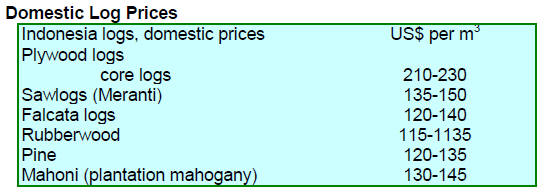

﹛
5. MYANMAR
Average Prices of sawn timber
Prices for sawn teak in the Open Tender held on 20
February averaged US$4500 per cubic ton for boards and
ranged from US$1000 to US$2000 per cubic ton for
Second Class teak scantlings. Third Class (the lowest
grade) scantlings sold for between US$500 and US$1000
per cubic ton.
Average prices in other tender sales were reported to be
MMK 0.651 million per h.ton for teak and MMK 0.372
million for other sawn hardwoods in the Mandalay
Division and MMK 0.632 for teak and MMK 0.359 for
hardwoods in the Yangon Division.
The following timber was sold by Myanma Timber
Enterprise by special open tender on 20 February 2015.
Prices for logs are expressed in hoppus tons and prices for
hewn or sawn teak are expressed in cubic tons.
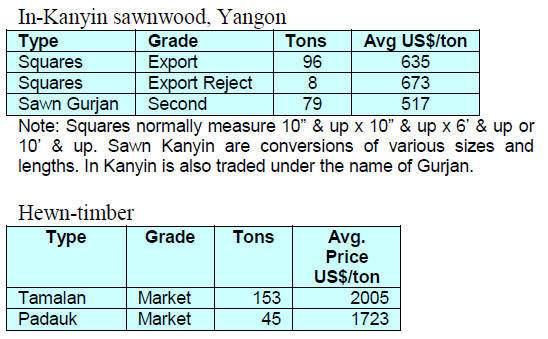
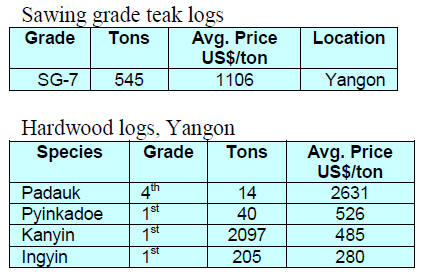
Forest loss along the Ayeyarwady River
The domestic press (Eleven Media) has reported a survey
conducted by ※Seine Yaung So§, a Mandalay-based
environmental group, on conditions along the upper
Ayeyarwady River where deforestation and water
pollution from gold mining sites is reportedly severe. The
group says deforestation can cause flooding, landslides
and soil erosion.
The survey of the Ayeyawady River will be presented to
the public as well as to experts and relevant authorities to
raise awareness of the need for greater protection efforts.
Trade deficit widens
The Myanmar Times of 18 February reported that the
trade deficit widened to MMK 2.3 trillion during the first
half of this fiscal year. Exports totalled K5.632 trillion
between April and September, far below the K8.018
trillion in imports.
The government‟s Planning and Financial Development
Joint Committee figures showed that the deficit for the
first half of FY 2013-14 was K394 billion, compared to
K2.386 trillion for the first half of the 2014-15.
Slower growth forecast by IMF
An International Monetary Fund (IMF) team led by
Yongzheng Yang visited Myanmar during January 28 to
February 5. The press release after the mission from the
IMF says: ※Real GDP growth is expected to decelerate
slightly to 7.8 percent in fiscal year (FY) 2014/15 (year
ending March) from 8.3 percent in FY2013/14 due to
slower growth in the agricultural sector.
Inflation is expected to pick up to around 6 percent year on
year (y/y) in FY2014/15 from 5.8 percent in FY2013/14.
The recent kyat depreciation is primary driven by the
global strengthening of the U.S. dollar and a widening
external current account deficit.
The trade deficit increased to 5.5 percent of GDP in
December 2014 as imports grew by 25 percent y/y for the
period April-December 2014 while exports growth
remained flat.§
For more see:
http://www.imf.org/external/np/sec/pr/2015/pr1548.htm
Correction: Timber exports to US to reach 300 cubic tons.
Volume 19 Number 3, 2015.
Barber Cho of the MTMA has advised that ※there was a
misinterpretation in the report on the IWPA trading with
Myanmar. It is NOT a waiver for ALL US companies to trade
with Myanmar. But it is a license for only IWPA members to
trade with Myanmar as long as we commit to a reform agenda."
6.
INDIA
US$4.5 billion investment in housing
The CREDAI newsletter of December last year reported
the real estate sector attracted US$4.5 billion in
investments between January and September last year with
Mumbai topping the list of recipients. Of the total
investment, land and development stage transactions
attracted nearly 60 per cent from domestic as well as
foreign entities.
See: http://www.credai.org/indian-realty-market-sees-45-
bn-investment-during-january-september-cbre-economictimes
Re-zoning Mumbai to boost housing development
In related news the VOX news site has an analysis of the
negative impact of restrictions on residential housing in
India and the initiative of the government to rezone parts
of Mumbai.
This rezoning says Matthew Yglesias in the VOX write-up
※is probably the most important urban-policy development
in the world today. It should fairly dramatically increase
living standards in one of the biggest cities on the planet
and possibly do a great deal to drive economic growth
forward throughout India.§
The VOX report says ※Greater Mumbai's governing
authority is proposing a sweeping change to the permitted
Floor Space Index (FSI, the ratio of a building's total floor
area to the size of the piece of land upon which it is built).
Under the plan, Mumbai is set to be divided into five
zones with an FSI of 8 allowed in the very densest areas
and FSIs in the 5-6 range in places well-served by mass
transit. Fifty-eight percent of the city's land area would
remain below 3.5, resulting in an increase in the amount of
building allowed in many areas.
Because Mumbai offers job opportunities people continue
to move into the city putting a massive strain on housing
development which is constrained by regulations which
have not keep pace with urbanisation. The VOX report
says in 2009 the Mumbai resident had an average
residential space only 12% of that of Shanghai residents.§
For more see: http:
www.vox.com/2015/2/20/8072575/mumbai-fsi-reform
Review of obsolete environmental legislation
planned
Government sponsored „brain-storming‟ on amendments
to laws on various aspects of environmental protection
will be conducted involving the Indian Forest Service
(IFS). The brain-storming sessions will be held in
Bengaluru, Bhopal and Guwahati.
Prakash Javadekar, the Environment Minister said a panel
had recently reviewed existing laws and suggested
amendments. The laws, which were reviewed by a fourmember
panel headed by former cabinet secretary T S R
Subramanian, are the Environment (Protection) Act, 1986,
the Forest (Conservation) Act, 1980, the Wildlife
(Protection) Act, 1972, the Water (Prevention and Control
of Pollution) Act, 1974 and the Air (Prevention and
Control of Pollution) Act, 1981.
The new government wants to review and remove
inappropriate or obsolete content from existing laws but
this is a huge task as there are over 2500 Acts on the
statute book of which the Prime Minister‟s office has
listed almost 2000 for repeal.
Canada promotes its wood products in India
Canada‟s largest softwood producers joined a governmentsponsored
trade mission to India to promote Canadian
wood products as sustainably sourced and environmentally
friendly.
Products made from Western Canadian species were
displayed at the DelhiWood trade show this January and
February, including doors, furniture and interior paneling.
Canadian wood products are also permanently displayed in
Mumbai and promoted by the government of British
Columbia/Canada to Indian manufacturers, importers,
interior designers and architects. Traditionally India uses
mainly hardwoods but is increasingly switching to more
use of softwoods.
Auction sales at depots of Western India
Because many buyers refused to attend the most recent eauction
as the terms of trade and the transparency in
dealings were considered unacceptable the sales were
postponed.
Domestic natural forest teak logs are preferred over
imported plantation teak as logs from domestic forests are
of a greater diameter and thus the sap is proportionally
smaller which results in higher recovery rates.
Teak log buyers are hopeful that their concerns on the eauction
process can be address providing for a quick
resumption of sales to clear the backlog of timber in the
depots.
Teak sales at Central India forest depots
The series of auctions in Central India continued and
prices were firmer as buyers were active having refused to
participate in the sales in Gujarat.
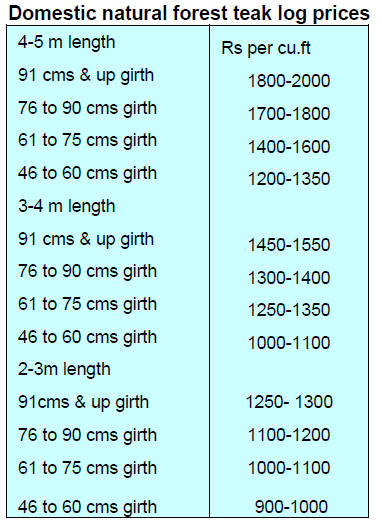
Current C&F prices for plantation teak
C&F prices have not changed over the past two weeks
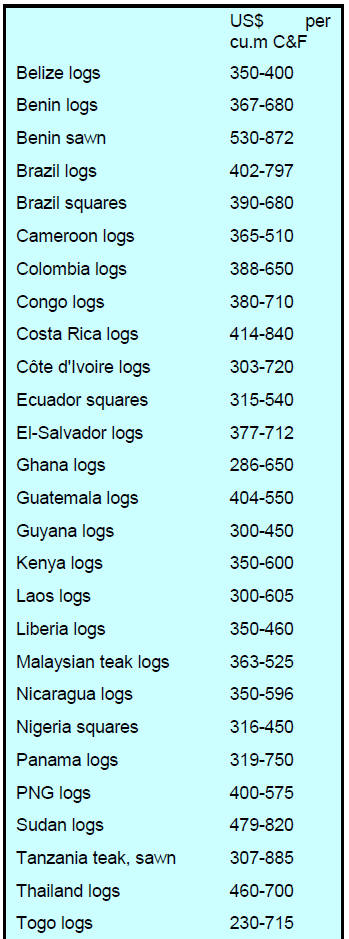

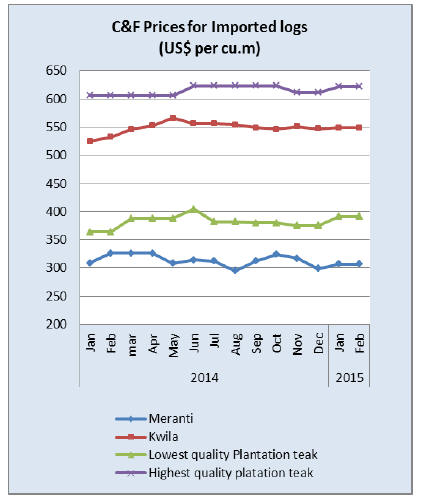
Prices for domestically milled sawnwood from
imported logs
Current exmill prices for air dried sawnwood are shown
below. Prices have not changed over the past two weeks.
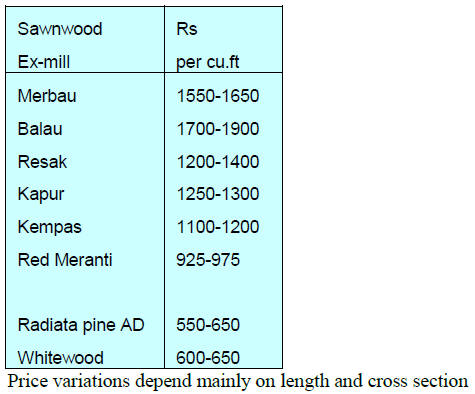
Prices for domestically milled Myanmar teak
Prices are generally stable but prices for decking have seen
a correction.
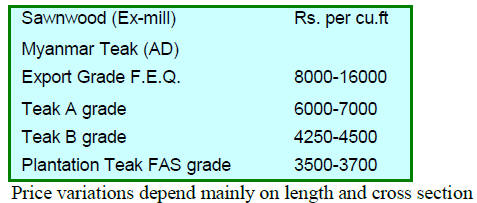
Imported 12% KD sawn wood prices per cu.ft
exwarehouse
No price changes have been reported
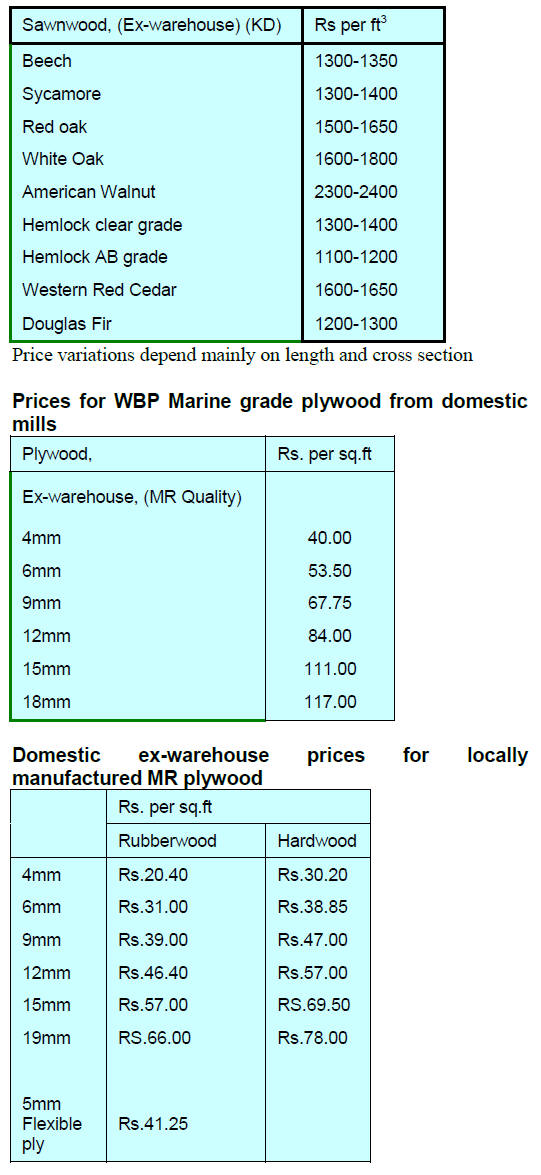
7.
BRAZIL
Interest rates soar in the face of
stubborn inflation
Brazil‟s Central Bank pushed interest rates higher at its
latest meeting lifting the rate from 11.75% to 12.25%.
This is the highest rate since August last year.
The move on interest rates comes as the Consumer Price
Index (IPCA), jumped to 1.24% in January 2015, after the
0.78% increase in December 2014.
The January inflation figure is another record
being the
highest since February 2003 (1.57%).
The Central Bank, in its Boletin Focus, a weekly Central
Bank survey of analysts from about 100 private financial
institutions, says the economy is expected to contract 0.5%
this year and that inflation will be above the government's
projection.
However, those surveyed for the Boletin analysis still
expect GDP to grow 1.5 percent in 2016. The Boletin
Focus says Brazil‟s inflation is likely to finish 2015 at just
over 7%, slightly higher than previously estimated.
For more see:
http://www.bcb.gov.br/pec/gci/ingl/Readout/R20150220.p
df
ABIMAD fair promotes new styles and concepts
The 19th ABIMAD fair (Associação Brasileira das
Ind迆strias de M車veis - Brazilian Association of Furniture
Industries) ran from 3-6 February attracting round 22,000
visitors (retailers and industry professionals) and recorded
business deals worth an estimated R$500 million.
Attendance at this years‟ fair was a 10% increase
compared to 2014.
The theme of the 19th ABIMAD was „Immerse yourself in
high decoration‟. According to Rafael Magno, of the
ABIMAD marketing department, upon entering the
pavilion, visitors were greeted by many different styles
and concepts for interior decoration.
The highly decorative furniture sector in Brazil is growing
faster than other sectors of the economy and trading values
are in the region of R$7 billion per year.
According to ABIMAD, output from this sector is
increasing to meet growing domestic demand which has
been sustained even under the current tough economic
conditions in the country.
Reforestation project in Tocantins
The Bank of Amazonia (BASA) approved R$51.3 million
in funding for industrial scale forest plantation
development in the state of Tocantins.
The initial funding will be for the establishment of 10,000
hectares of eucalyptus plantations across 39 properties in
the municipalities of Wanderlândia, Darcin車polis, Nova
Olinda, Goiatins, Babaçulândia, Filad谷lfia and
Palmeirante. The purpose is to produce pulp logs, biomass
raw material and sawlogs.
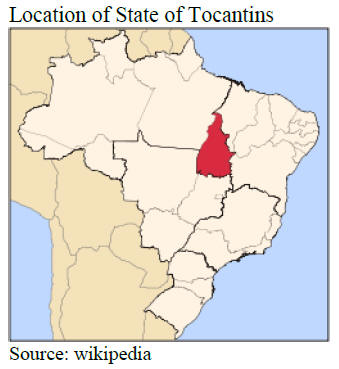
The project aims to promote the economies in the
region
through job creation. The total investment in the
plantations is projected at R$64.2 million of which R$12.9
will be provided by the private sector and R$ 51.3 from
BASA.
January export round-up
In January 2015, Brazilian exports of wood-based
products (except pulp and paper) increased 7.6% in value
compared to January 2014, from US$ 174.2 million to
US$ 187.5 million.
Pine sawnwood exports increased significantly (28%) in
value in January 2015 compared to January 2014, rising
from US$13.9 million to US$17.8 million. In volume,
exports rose 25%, from 61,000 cu.m to 76,400 cu.m over
the same period.
Tropical sawnwood exports were up 22.4% in volume,
from 22,800 cu.m in January 2014 to 27,900 cu.m in
January 2015. In terms of value, exports increased 12.5%
from US$13.6 million to US$15.3 million, over the same
period.
Pine plywood exports also increased ring almost 17% in
value in January 2015 in comparison with January 2014,
from US$27.2 million to US$31.8 million. The volume of
pine plywood exports increased 14%, from 74,900 cu.m to
85,300 cu.m, over the same period.
Surprisingly tropical plywood exports also increased in
January from 2,200 cu.m in January 2014 to 5,500 cu.m
this January. The value of tropical timber exports
increased 100% from US$1.4 million in January 2014 to
US$2.8 million in January 2015.
However, wooden furniture exports fell from US$29.9
million in January 2014 to US$26.4 million in January
2015, a 12% decline.
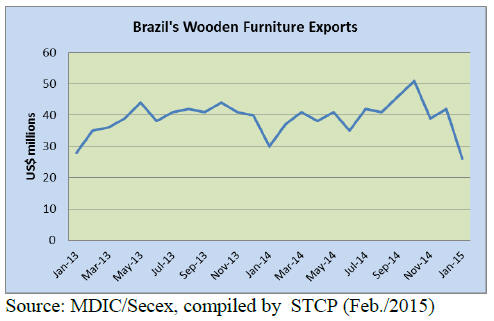
In previous issues it was reported that furniture
exports
from the Bento Gonçalves furniture cluster (one of the
main clusters of Rio Grande do Sul state) have fallen.
Especially badly affected was demand in Argentina (-
59%) and Venezuela (-52%).
Project &Orchestra Brazil* in 2015
The 2015 calendar for the project „Orchestra Brazil‟, a
partnership between Bento Gonçalves Furniture Industry
Union (SINDIMÓVEIS) and the Brazilian Agency for
Export and Investment Promotion (APEX-Brazil), has
been set out.
The project aims to enhance integration of furniture
industries in their approach to international markets. The
2015 calendar of events includes fairs, meet buyer projects
and missions in South Africa, Germany, Argentina,
Bolivia, Chile, Colombia, United States, Italy, Guatemala,
Mexico and Turkey.
The first activity of the year was a sponsored visit by four
companies to the Kitchen and Bath Industry Show (KBIS)
in Las Vegas. „Orchestra Brazil‟ will be one of the
supporters of the March Fimma Brazil Buyer Project
(International Fair of Machines, Raw Materials and
Accessories for the Furniture Industry) which will take
place in Bento Gonçalves (Rio Grande do Sul State).
In 2015, „Orchestra Brazil‟ introduced changes which now
segment participating industries by their export capacity so
that activities can be tailored to the various companies.
Companies are now classified as those new to exporting,
beginner exporters, regular exporters and experienced
international exporters. The categories are not related to
the size of the company but to their willingness and
experience in exporting.
The companies about to enter the export market will be
provided with information on foreign markets. Those
companies that are in the initial phase of exporting will get
support to diversify their markets; companies with solid
exports will focus on increasing competitiveness and
companies firmly established in international markets will
be supported to increase global market share.
Currently, the project has the participation of 73 industries
and 50 design studios.
The priority markets for 2015 are South Africa,
Guatemala, Mexico, United States, Argentina, Colombia,
Peru, Turkey, Bolivia and Chile.
For more see:
http://www.sindmoveis.com.br/portal/
Forest sector exports in 2014
Brazilian exports of pulp, paper and timber in 2014 were
valued at US$5.29 billion, US$ 1.93 billion and US$ 2.73
billion, respectively according to the Secretariat of
Agricultural Policy (SPA), the Ministry of Agriculture,
Livestock and Food Supply (MAPA). The value of
primary forest production exceeded R$13 billion and the
sector employed some 4.5 million people.
Planted forests in Brazil extend to 7.6 million hectares or
approximately 1% of production forest area of the country.
This sector accounts for 75% of all that is consumed by
forest-based industries in the country. The gross domestic
product of the sector was US$56 billion, representing
1.2% of all wealth generated in the country.
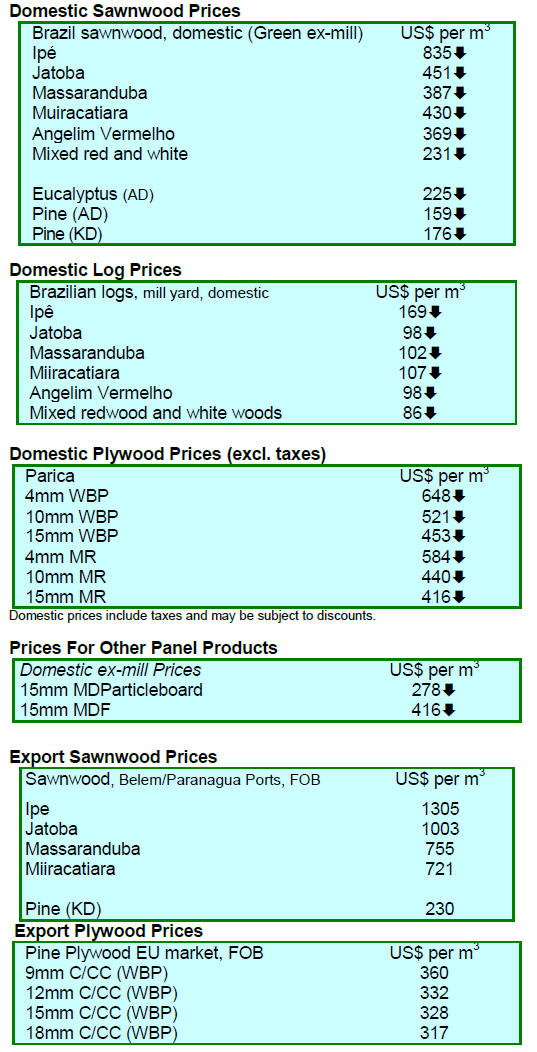

﹛
8. PERU
Private companies invest in plantations
ICCGSA Investments expects the first harvest of bolaina
(Guazuma crinita) to be made shortly from its plantations
in the province of Puerto Inca.
To-date the company has established just over 1,000
hectares in cooperation with Reforestadora Amazonica
S.A. This company is responsible for planting,
maintaining, harvesting and converting the timber wood.
CIFOR says ※Bolaina has traditionally been used in places
such as Contamana as a cheap wood for construction.
Demand for bolaina surged in 2007, after a strong
earthquake leveled the city of Pisco, on Peru‟s southern
coast and manufacturers bought large amounts of the
wood for prefabricated houses.§
Exporters expect recovery in 2015
Noting that 2014 was an unremarkable year for the timber
sector, Erik Fischer, chairman of the Wood and Wood
Industry Association of Exporters (ADEX), said that 2015
may be the year in which the industry could realise the
long-awaited recovery.
Currently, regional export markets are weakening.
Demand in the US is improving but buyers for the
Mexican market are quiet and in Europe there still
considerable volatility.
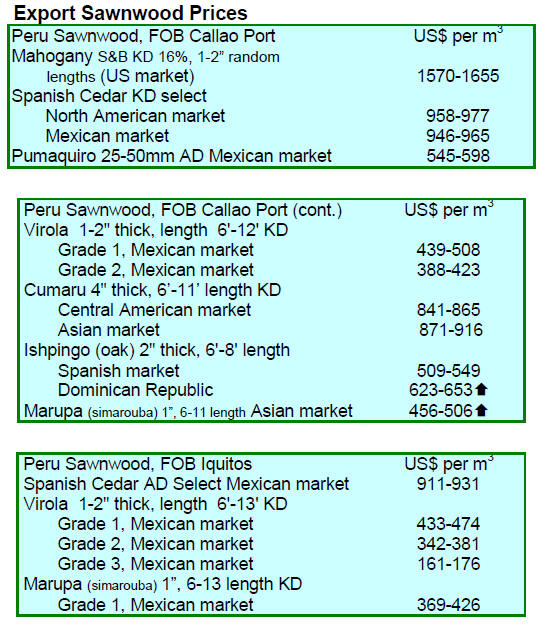
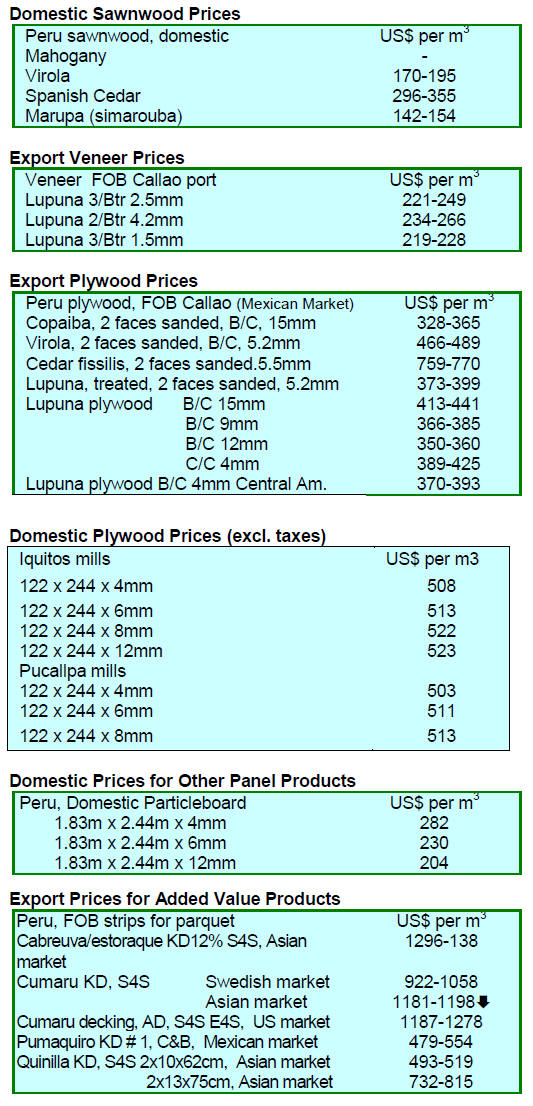
9.
GUYANA
Focus on value-added production
A sharper focus on value-added production and
dissemination of information on the implications of the
Guyana EU/FLEGT agreement that is now being
negotiated are among the priority areas in the forestry
sector identified in the new five year (2015-2019) strategic
plan formulated by Forest Products Development and
Marketing Council of Guyana (FPDMC).
It is envisaged that the EU/FLEGT agreement will open up
greater market opportunities for Guyana‟s timber products.
With this in mind, the FPDMC will be embarking on a
sensitisation drive which will be designed to inform
stakeholders on the conditions that would have to be met
in order for Guyana to be compliant with this agreement.
As such these would include methodology and
legality
with respect to harvesting of timber and chain of custody
of forest products. Additionally stakeholders will also be
informed of the need to maintain a high level of quality of
timber products.
The FPDMC is set up to work with stakeholders to
promote the sustainability of the country‟s forest products
by increasing value-added and competitiveness through
improved capability and enhanced trade opportunities and
market access.
In related news, leaders of Guyana‟s Amerindian
communities, while welcoming the efforts to strengthen
forest management, have called for Amerindian land rights
to be secured and more community involvement in the
negotiations on the VPA.
Export prices
There were no exports of greenheart or mora logs in the
period reported.
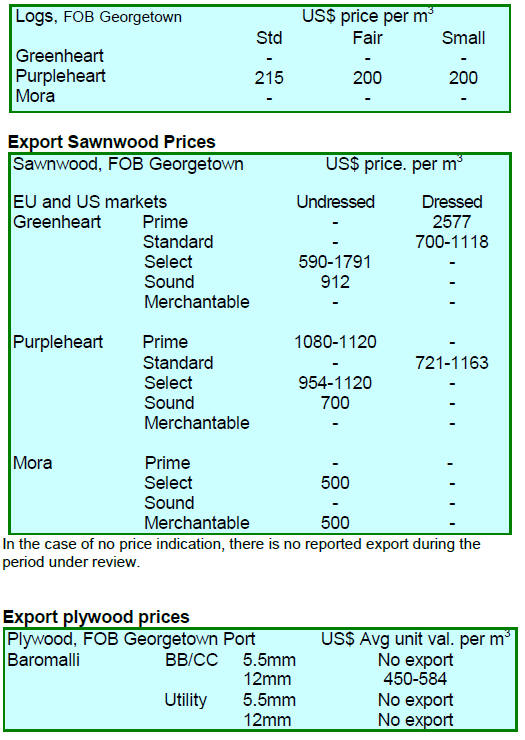
﹛
